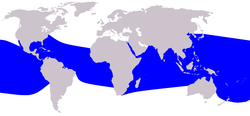Spinner Dolphins
|
|
| Spinner Dolphin Conservation status: Lower risk | ||||||||||||||||||
|---|---|---|---|---|---|---|---|---|---|---|---|---|---|---|---|---|---|---|
| Scientific classification | ||||||||||||||||||
| ||||||||||||||||||
| Binomial name | ||||||||||||||||||
| Stenella longirostris (Gray, 1828) | ||||||||||||||||||
 Spinner Dolphin range |
The Spinner Dolphin (Stenella longirostris) is a small dolphin found in off-shore tropical waters around the world. It is famous for its acrobatic displays in which they will spin longitudinally along their axis as they leap through the air.
| Contents |
Taxonomy
The Spinner Dolphin is sometimes referred to as the Long-snouted Spinner Dolphin, particularly in older texts, to distinguish it from the similar Clymene Dolphin which is often called the Short-snouted Spinner Dolphin. The species was discovered by John Gray in 1828. There are four named subspecies:
- Eastern Spinner Dolphin (S. l. orientalis), found in the tropical eastern Pacific.
- Central American or Costa Rican Spinner Dolphin (S. l. centroamericana), also found in the tropical eastern Pacific.
- Gray's or Hawaiian Spinner Dolphin (S. l. longirostris), found in the central Pacific around Hawaii but represents a mixed bag of broadly similar subtypes found throughout the world.
- Dwarf Spinner Dolphin (S. l. roseiventris), first found in the Gulf of Thailand.
However the species display a greater variety than these subspecies might indicate. A hybrid form characterized by its white belly is noted in the eastern Pacific. Other less distinct groupings have been identified in other oceans.
The specific name comes from the Latin for long-beaked.
Physical description
The bulk of the dolphin is dark grey, with darker patches in the tail stock, back and throat. Usually it has creamy-white patch on the belly though this varies considerably. The beak is distinctively long and thin, with a dark tip. The fins too are lengthy for dolphins of this size. The dorsal fin is erect and even leans forward in older males found in the eastern Pacific. However this description has to be described as a little loose - Spinner Dolphins are the most variable in form of all cetaceans.
Adults have varied in size from 129cm to 235cm and weight from 23kg-78kg. The gestation period is 10 months. Individuals reach maturity at 4-7 years (females) and 7-10 years (females). Longevity is unknown.
Spinners congregate in groups that vary from just a few dolpins to great schools numbering in the thousands. They are consistly acrobatic and keen bow-riders. The reason for the creature's spinning is not known. One suggestion is that the great cauldron of bubbles created on exit and re-entry make act as a target for echolocation by other individuals in the school. It may also be simply play-acting. Individuals have been spotted completing at least 14 spinning jumps in quick succession.
In the Atlantic the Spinner may be mistaken for the Clymene Dolphin which also spins, but not to such a regular and dramatic extent. The species also shares common characteristics with the Pantropical Spotted Dolphin.
Population and distribution
Spinner Dolphins occur in pelagic tropical waters in all the world's major oceans. Their greatest populations density occur between the Tropics of Cancer and Capricorn. Although described as pantropical the species roughly divides up into geographical areas corresponding to subspecies. The total population is unknown and was certainly dramatically reduced by fishing activity in the eastern Pacific, but is still regarded as common.
Human interaction
Spinner Dolphins have been studied both in the wild and in captivity in Hawaii. Up to two million Spinner Dolphins, mostly eastern and white-bellied varieties, were killed in the thirty years after purse seine fishing for tuna was introduced in the 1950s. The process killed probably half of all Eastern Spinner Dolphins. See Pantropical Spotted Dolphin for a discussion.
Although not caught in purse seine nets, spinner dolphins in Hawaii can be subjected to multiple daily visits to their nearshore resting grounds. If continued without strong regulations, the magnitude of people desiring wild dolphin encounters and some not-so-ethical tour operators exploiting the proximity of nearshore dolphin habitats while guaranteeing up-close interactions may result in the "loving nature to death" syndrome as found in similar areas, e.g. the Orca's of the Pacific Northwest.
